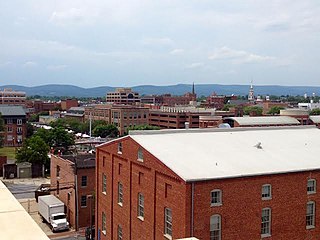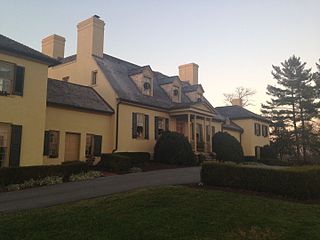
Samples Manor is an unincorporated community in Washington County, Maryland, United States. [1] The Kennedy Farm was listed on the National Register of Historic Places in 1973. [2]

Samples Manor is an unincorporated community in Washington County, Maryland, United States. [1] The Kennedy Farm was listed on the National Register of Historic Places in 1973. [2]

On October 1, 1764, a patent was approved for 10,160 ¼ acres in extreme southern Washington County, (then Frederick County) Maryland for a prominent businessman named John Semple of Charles County. Such large properties were categorized as manors in colonial Maryland, with their own unique laws. The tract was named Keep Treist by Semple, but took on the popular name of Semple's Manor, which became “Sample’s Manor.” [3] John Semple was an innovator in colonial America with unique vision and goals. He was not attentive to his financial affairs, however, and within a decade of acquiring Keep Treist, John Semple was bankrupt. Most of Keep Treist would be acquired by the Frederick Forge, later to become the Antietam Iron Works. By the mid-19th century much of the forest had been harvested and converted to charcoal to fuel the iron works. The cleared land was then sold for farms and lots. These land sales increased after the unexpected death of Iron Works owner John Brein in 1849. The most famous resident of Sample's Manor would only live there for four months in 1859 at the nearby Kennedy Farm. The abolitionist John Brown and his cadre of followers would make history on October 16, 1859, with their raid on the U.S. Armory, three miles away at Harper's Ferry. The Sample's Manor Church of God is thought to have originated circa 1850. The cemetery holds generations of ancestors to many who live nearby yet today. Sample's Manor and the Kennedy Farm were the unlikely site of a major development plan by prominent African Americans in the 1960s. "John Brown's Farm" included performances by dozens of the top R&B musicians of the late 20th century. [4]


Frederick County is located in the northern part of the U.S. state of Maryland. As of the 2010 U.S. Census, the population was 240,336. The county seat is Frederick.

Cecil County is a county located in the U.S. state of Maryland at the northeastern corner of the state, bordering both Pennsylvania and Delaware. As of the 2010 census, the population was 101,108. The county seat is Elkton. The county was named for Cecil Calvert, 2nd Baron Baltimore (1605–1675), the first Proprietary Governor of the Province (colony) of Maryland. It is part of the Philadelphia-Camden-Wilmington, PA-NJ-DE-MD Metropolitan Statistical Area. Cecil County has existed since the late 1600s, though it continued to grow in population and town size. The county is located in Wilmington's Radio Market and Philadelphia's Designated Market Area.

Rohrersville is a census-designated place (CDP) in Washington County, Maryland, United States. The population was 175 at the 2010 census.

Clarksville is an unincorporated community in Howard County, Maryland; the second highest-earning county in the United States according to the U.S. Census Bureau. The community is named for William Clark, a farmer who owned much of the land on which the community now lies and served as a postal stop that opened on the 4th of July 1851.

Doughoregan Manor is a plantation house and estate located on Manor Lane west of Ellicott City, Maryland, United States. Established in the early 18th century as the seat of Maryland's prominent Carroll family, it was home to Charles Carroll, a signer of the United States Declaration of Independence, during the late 18th century. A portion of the estate, including the main house, was designated a National Historic Landmark on November 11, 1971. It remains in the Carroll family and is not open to the public.

John Brown's Fort was originally constructed in 1848 for use as a guard and fire engine house by the federal Harpers Ferry Armory in Harpers Ferry, Virginia. An 1848 military report described the building as "An engine and guard-house 35 1/2 x 24 feet, one story brick, covered with slate, and having copper gutters and down spouts…"

St. Charles College was a minor seminary in Catonsville, Maryland, originally located in Ellicott City, Maryland.

Principio Furnace and village is in Cecil County, Maryland, 4 miles (6.4 km) northeast of Havre de Grace, MD.

The Kennedy Farm is a National Historic Landmark property on Chestnut Grove Road in rural southern Washington County, Maryland. It is notable as the place where the radical abolitionist John Brown planned and began his raid on Harpers Ferry, Virginia, in 1859. Also known as the John Brown Raid Headquarters and Kennedy Farmhouse, the log, stone, and brick building has been restored to its appearance at the time of the raid. The farm is now owned by a preservation nonprofit.

Schifferstadt, Also known as Scheifferstadt, is the oldest standing house in Frederick, Maryland. Built in 1758, it is one of the nation's finest examples of German-Georgian colonial architecture. It was designated a National Historic Landmark in 2016.

John Brown's raid on Harpers Ferry was an effort by abolitionist John Brown, from October 16 to 18, 1859, to initiate a slave revolt in Southern states by taking over the United States arsenal at Harpers Ferry, Virginia. It has been called the dress rehearsal for, or Tragic Prelude to, the Civil War.

Rose Hill Manor, now known as Rose Hill Manor Park & Children's Museum, is a historic home located at Frederick, Frederick County, Maryland. It is a 2+1⁄2-story brick house. A notable feature is the large two-story pedimented portico supported by fluted Doric columns on the first floor and Ionic columns on the balustraded second floor. It was the retirement home of Thomas Johnson (1732–1819), the first elected governor of the State of Maryland and Associate Justice of the United States Supreme Court. It was built in the mid-1790s by his daughter and son-in-law.

HagerstownHAY-gərz-town is a city in Washington County, Maryland, United States and the county seat of Washington County. The population of Hagerstown city proper at the 2010 census was 39,662, and the population of the Hagerstown-Martinsburg Metropolitan Area was 269,140. Hagerstown ranks as Maryland's sixth-largest incorporated city.

Johnsville is an unincorporated community in Frederick County, Maryland, United States. It is located approximately halfway between Libertytown and Union Bridge along Maryland Route 75. The Kitterman-Buckey Farm was listed on the National Register of Historic Places in 2005.
Burtner is an unincorporated community in Washington County, Maryland, United States. Search Well was listed on the National Register of Historic Places in 1983.

Raspberry Plain is a historic property and former plantation in Loudoun County, Virginia, near Leesburg. Raspberry Plain became one of the principal Mason family estates of Northern Virginia, and was rebuilt in the early 20th century. It currently operates as an event site, hosting weddings and other special events year round.
Tuscarora Creek is a 7.7-mile-long (12.4 km) tributary of the Monocacy River in Frederick County, Maryland, in the United States.
Kennedy House or Kennedy Farm or Kennedy Cottage may refer to:

The Belmont Estate, now Belmont Manor and Historic Park, is a former forced-labor farm located at Elkridge, Howard County, Maryland, United States. Founded in the 1730s and known in the Colonial period as "Moore's Morning Choice", it was one of the earliest forced-labor farms in Howard County, Maryland. Its 1738 plantation house is one of the finest examples of Colonial Georgian architectural style in Maryland.

John Brown Farm, Tannery & Museum, 17620 John Brown Rd., Guys Mills, PA 16327, is a historic archaeological site located in Richmond Township, Crawford County, Pennsylvania. The tannery was built in 1825 by famed abolitionist John Brown (1800–1859), who lived on the site from 1825 to 1835. It was a major stop on the Underground Railway; Brown helped some 2,500 slaves during this period. The site includes the ruins of the tannery, a one-story, rectangular structure measuring 55 by 22 feet. There was a hidden, well-ventilated room in the barn for the fugitive slaves.
Coordinates: 39°22′19″N77°43′12″W / 39.37194°N 77.72000°W